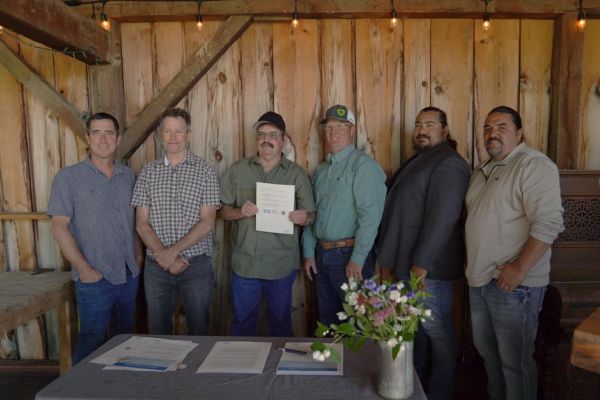
- Details
- By Darren Thompson
The Scott River is a tributary of the Klamath River, one of the largest rivers in California. The Scott River provides a unique and highly productive habitat for Chinook salmon, coho salmon, which is listed as threatened on the Endangered Species Act, steelhead, and Pacific lamprey—which the Yurok Tribe depends on for sustenance and ceremony. According to CalTrout, the Scott River is the most productive coho salmon stream in all of California.
“The Yurok Tribe initiated this unique partnership in an effort to develop cooperative, mutually beneficial solutions that help the Scott River’s salmon runs to recover,” Yurok Tribal Council Member Ryan Ray said in a statement. “We believe that strong fish runs and resilient ranching operations can coexist in the Scott River Valley. This agreement establishes the necessary framework to make it happen.”
Representatives from the Yurok Tribe, CalTrout and Farmers Ditch Company convened at the Scott River Ranch to sign the MOU on June 15. There, leaders spoke of the history of the Scott River and how its future depends on collaboration.
“We all rely on water – including our fish – and my team is excited to be a member of this innovative partnership working toward a future for water security and functioning ecosystems,” said CalTrout’s Mount Shasta-Klamath Regional Director Damon Goodman in a statement. “This could be a real win-win for fish, farms, and California’s Tribal communities.”
According to a statement by CalTrout, the partnership is aimed at restoring salmon habitat and improving on-farm water use efficiency on the mainstem Scott River. It is being led by the Yurok Tribe and funded by the California Department of Fish and Wildlife. Other organizations have pledged to restore the river’s health, including the Yurok and Karuk Tribes, Scott River Water Trust, Farmers Ditch Company, CalTrout and others will be announced as the project develops.
Fish populations in the area have been declining due to an extended drought in the region, pollution left from the gold mining era, and diseases stemming from the Klamath River. For years, California Tribes have advocated with other conservation groups to remove the Klamath River Dams, which they say have harmed more than 400 miles of river habitat and degraded water quality for people and wildlife.
After decades of advocacy, in November 2022, the U.S. Federal Energy Regulatory Commission voted unanimously to approve a $500 million dam removal project on the Klamath River. Four dams were built between 1908 and 1962 on the Klamath River, from Oregon to northwestern California, named Copco No. 1, Copco No. 2, Iron Gate, and JC Boyle. Proponents of the dams have said that dam removal would open up hundreds of miles of salmon habitat. When completed, the removals will be the largest dam removals in the world.
The MOU’s habitat and water system improvements will complement the ongoing efforts by CalTrout and others to restore the Scott River – including the upstream tributaries — East Fork and South Fork Scott River.
“I hope this work will one day serve as a model that can be duplicated from the Klamath River’s headwaters to the coast,” concluded Yurok Tribe Vice Chairman Frankie Myers.
More Stories Like This
Klamath Indigenous Land Trust Purchases 10,000 Acres as Salmon ReturnTrump signs law that revokes some limits on drilling in Alaska’s National Petroleum Reserve
Southern Sierra Miwuk Nation Gets 900-Acres ofLand Back
Chilkat Indian Village Tells New Palmer Mine Owners They Are “Not Welcome” in Chilkat Valley
Tribes, Coastal Group Ask Army Corps to Revoke Permit for Texas Export Terminal
Help us defend tribal sovereignty.
At Native News Online, our mission is rooted in telling the stories that strengthen sovereignty and uplift Indigenous voices — not just at year’s end, but every single day.
Because of your generosity last year, we were able to keep our reporters on the ground in tribal communities, at national gatherings and in the halls of Congress — covering the issues that matter most to Indian Country: sovereignty, culture, education, health and economic opportunity.
That support sustained us through a tough year in 2025. Now, as we look to the year ahead, we need your help right now to ensure warrior journalism remains strong — reporting that defends tribal sovereignty, amplifies Native truth, and holds power accountable.
 The stakes couldn't be higher. Your support keeps Native voices heard, Native stories told and Native sovereignty defended.
The stakes couldn't be higher. Your support keeps Native voices heard, Native stories told and Native sovereignty defended.
Stand with Warrior Journalism today.
Levi Rickert (Potawatomi), Editor & Publisher

